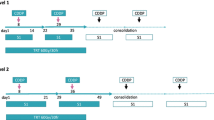Background:
In elderly patients, patients with multiple morbidities, and patients with a reduced general condition, the standard treatment of inoperable non-small-cell lung cancer (NSCLC) consists of either chemotherapy or radiation therapy alone and is associated with an extremely poor prognosis. We therefore investigated the feasibility, toxicity, and efficacy of radiotherapy with concurrent chemotherapy using vinorelbine plus cisplatin or carboplatin in NSCLC patients at risk for treatment complications.
Patients and Methods:
A total of 33 patients (six women, 27 men, median age 65 years) with locally advanced, functionally inoperable pulmonary carcinomas, recurrent lung cancer or postoperative macroscopic residual tumors (R2) with an increased risk of treatment complications (WHO performance status 2/3; cardiac, renal or pulmonary failure; marked pretherapeutic weight loss; age between 71–75 years) received 12.5 mg of vinorelbine per m2 body surface area (BSA) on days 1, 8, 15, 29, 36 and 43 plus either cisplatin 20 mg/m2 BSA (ten patients) or carboplatin 70 mg/m2 BSA (23 patients) on days 1–5 and 29–33 together with conventionally fractionated radiotherapy. The tumor regions were irradiated with doses of up to 63 Gy (90% isodose), and potentially affected lymph nodes received doses of up to 45.0 or 50.4 Gy (90% isodose).
Results:
Briefly, 31 of 33 patients successfully completed radiation therapy and 26 received four cycles of vinorelbine plus at least two cycles of cisplatin or carboplatin. Hematotoxic side effects included grade III leukocytopenia (n = 8), grade III thrombocytopenia (n = 5), and grade IV thrombocytopenia (n = 2). Other side effects consisted of peripheral neuropathy grade III (n = 1) and esophagitis grade IV (n = 1). Severe pneumonitis did not occur. Six patients had pneumonia before radiochemotherapy. 21 patients (63%) exhibited a complete (n = 7) or partial response (n = 14) to chemoradiation. The twelve nonresponders had either stable (n = 9) or progressive disease (n = 3). The survival rates plus standard deviations were as follows: 1-year survival: 60 ± 8%, 2-year survival: 36 ± 9%, 3-year survival: 24 ± 9%, median survival time: 17 months (5;29 months; 95% confidence interval [CI]), median progression-free survival: 11 months (9;13 months; 95% CI). The median follow-up time was 14 months.
Conclusion:
Conventionally fractionated radiochemotherapy with vinorelbine plus a platinum derivative is feasible in patients with NSCLC and increased risk of treatment complications. Compared to patient populations described in the literature, the survival rates achieved by concurrent radiochemotherapy appear to be better than those achieved with radiotherapy alone.
Hintergrund:
Eine alleinige Bestrahlung oder Chemotherapie ist therapeutischer Standard bei multimorbiden, alten oder im Allgemeinzustand reduzierten Patienten mit inoperablen nichtkleinzelligen Bronchialkarzinomen (NSCLC). Die Prognose ist außerordentlich schlecht. Deshalb untersuchten wir die Durchführbarkeit, Toxizität und Wirksamkeit einer simultanen Radiochemotherapie mit Vinorelbin und Cisplatin oder Carboplatin bei Patienten mit NSCLC und erhöhtem Behandlungsrisiko.
Patienten und Methodik:
33 Patienten (sechs Frauen, 27 Männer, medianes Alter 65 Jahre) mit einem lokal fortgeschrittenen, funktionell inoperablen Bronchialkarzinom, Bronchialkarzinomrezidiv oder postoperativem makroskopischen Residualtumor (R2) mit erhöhten Behandlungsrisiken (WHO-Performance-Status 2/3 oder kardiale oder renale oder pulmonale Insuffizienz oder ausgeprägter prätherapeutischer Gewichtsverlust oder Alter zwischen 71 und 75 Jahren) erhielten 12,5 mg/m2 Körperoberfläche (KO) Vinorelbin an den Tagen 1, 8, 15, 29, 36 und 43 sowie Cisplatin 20 mg/m2 KO (zehn Patienten) oder Carboplatin 70 mg/m2 KO (23 Patienten) an den Tagen 1–5 und 29–33 zusammen mit einer konventionell fraktionierten Strahlentherapie der Tumorregionen bis 63 Gy (90%-Isodose) und potentiell befallener Lymphknoten bis 45,0 bzw. 50,4 Gy (90%-Isodose).
Ergebnisse:
Die Bestrahlung wurde bei 31 von 33 Patienten in voller Dosierung und die Chemotherapie bei 26 Patienten mit mindestens zwei Kursen Cisplatin oder Carboplatin und vier Kursen Vinorelbin durchgeführt. Hämatotoxische Nebenwirkungen schlossen Leukozytopenien Grad III (n = 8), Grad-III-Thrombozytopenien (n = 5) und Grad-IV-Thrombozytopenien (n = 2) ein. Sonstige Nebenwirkungen: periphere Neuropathie Grad III (n = 1) und Ösophagitis Grad IV (n = 1). Es war keine höhergradige Pneumonitis zu verzeichnen. Sechs Patienten hatten eine Pneumonie, die jeweils bereits vor Therapiebeginn bestand. 21 Patienten (63%) zeigten entweder eine komplette (n = 7) oder eine partielle Remission (n = 14) auf die Radiochemotherapie. Die zwölf Patienten ohne Therapieansprechen hatten entweder eine “stable disease“ (n = 9) oder waren progredient (n = 3). Die Überlebensraten einschließlich Standardabweichungen betrugen: 1-Jahres-Überlebensrate: 60 ± 8%, 2-Jahres-Überlebensrate: 36 ± 9%, 3-JahresÜberlebensrate: 24 ± 9%, mediane Überlebenszeit: 17 Monate (5;29 Monate; 95%-Konfidenzintervall [KI]), medianes progressionsfreies Überleben: 11 Monate (9;13 Monate; 95%-KI). Die mediane Nachbeobachtungszeit lag bei 14 Monaten.
Schlussfolgerung:
Eine konventionell fraktionierte Radiochemotherapie mit Vinorelbin und einem Platinderivat ist bei Patienten mit NSCLC und erhöhten Therapierisiken durchführbar. Verglichen mit aus der Literatur bekannten Ergebnissen einer alleinigen Bestrahlung scheinen durch eine simultane Radiochemotherapie bessere Überlebensraten möglich.
Similar content being viewed by others
Author information
Authors and Affiliations
Corresponding author
Rights and permissions
About this article
Cite this article
Semrau, S., Bier, A., Thierbach, U. et al. Concurrent Radiochemotherapy with Vinorelbine plus Cisplatin or Carboplatin in Patients with Locally Advanced Non-Small-Cell Lung Cancer (NSCLC) and an Increased Risk of Treatment Complications. Strahlenther Onkol 179, 823–831 (2003). https://doi.org/10.1007/s00066-003-1127-8
Received:
Accepted:
Issue Date:
DOI: https://doi.org/10.1007/s00066-003-1127-8




